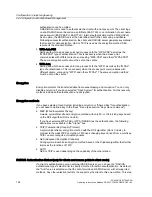
Configuration / project engineering
5.6 Configuration with Web Based Management
SCALANCE W786-xPRO
Operating Instructions, Release 08/2007, C79000-G8976-C221-02
123
5.6.5.2
Basic Wireless menu command
Authentication
Authentication basically means that some form of identification is required. Authentication
therefore protects the network from unwanted access. In the "Security Level" box, you can
choose between the following types of authentication:
●
Open System
There is no authentication. Encryption with a fixed (unchanging) key can be selected as
an option. To do this, define a key in the "Keys" menu. 5 or 13 ASCII or 10 or 26
hexadecimal characters specify a weaker key (40/104 bits). 16 ASCII or 32 hexadecimal
characters, on the other hand, define a strong key (128 bits). Then select "Encryption" in
the "Basic WLAN" menu.
Note
With the following devices in iPCF mode, only this setting is possible:
•
SCALANCE W788-xRR in client mode
•
SCALANCE W784-xRR in client mode
•
SCALANCE W747-1
•
SCALANCE W747-1RR
•
IWLAN/PB-Link PNIO
●
Shared Key
In Shared Key authentication, a fixed key is stored on the client and access point. This is
then used for authentication and encryption. In this case, you will have to store a WEP
key after selecting "Low (Shared Key)".
Note
Only in access point mode:
When using an open system with encryption or shared key in conjunction with ACL lists,
note the information in Section "ACL menu command".
●
WPA2-PSK
WPA2-PSK is based on the WPA2 standard, WPA authentication, however, operates
without a RADIUS server. Instead of this, a key (pass phrase) is stored on every client
and access point and this is used for authentication and further encryption. AES or TKIP
is used as the encryption method, AES represents the standard method.
Note
The key can be 8 to 63 ASCII characters or exactly 64 hexadecimal characters long. It
should be selected so that is complex, (for example consisting of random numbers,
letters (upper-/lowercase), have few repetitions and special characters). Do not use
known names, words and terms that could be guessed. If a device is lost or if the key
becomes known, the key should be changed on all devices to maintain security.
●
WPA2
WPA2 (Wi-Fi Protected Access 2) is a further development of WPA and implements the
functions of the IEEE 802.11i security standard. WPA2 uses the additional encryption
protocol CCMP with preauthentication that allows fast roaming in mobile ad hoc
networks. A client can log on in advance at several access points so that the normal
















































